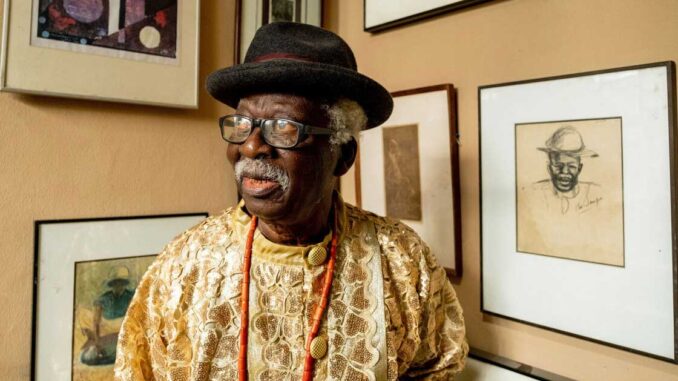
Reputed as one of the most successful artists to have emerged from West Africa, nay Africa in the 20th century, Bruce Obomeyoma Onobrakpeya is not only the grand father of modern Nigerian art, he is also widely regarded as ‘‘the pride of all Nigerians.’’ He has a continuing and commanding influence on the generation of artists who have come to maturity in the post colonial period in Nigeria.
A living art avatar, who shares the same hallowed platform with Picasso, Leonardo da Vinci and Michael Angelo in the universal configuration of artistic influence, he is the recipient of the Living Human Treasure Award (2006) given by UNESCO.
Born August 30, 1932 in Agbarha-Otor, Delta State, the printmaker, painter and sculptor, is the son of an Urhobo carver. He was raised as a Christian, but also learned the traditional beliefs. His family moved to Benin City, Edo State, when he was a child. He attended Western Boys High School, where Edward Ivehivboje taught him art, among other subjects. He also attended drawing classes at the British Council Art Club in Benin City. He was equally inspired by the watercolour paintings of Emmanuel Erabor.
The most significant moment of his academic training was, when he, and a few other students of his generation at the Nigerian College of Arts, Science and Technology, now the Ahmadu Bello University, Zaria, led by Uche Okeke, formed the Zaria Arts Society, later called the Zaria Rebels, on October 9, 1958, with the aim of ‘decolonising’ the visual arts as taught by expatriate Europeans.
Onobrakpeya admits that the college gave him technical skills but the Zaria Arts Society, a discussion group, shaped his perspectives as a professional artist. The society gave him the confidence to seek a personal expressive idiom. He elongated his figures, ignored perspective and evoked the supernatural through ambiguous decorations.
Since 1966, as an experimental artist, Onobrakpeya has discovered, innovated and perfected several techniques both in printmaking and relief sculpture that are uniquely Nigerian. Generally, printmaking is a fine art process of producing pictures from a plate, which the artist has previously created.
Having conceived the idea, the artist then creates an image or images on a plate through any of the printmaking techniques. The images are then transferred onto a paper or any other surface by printing or embossing method. At the same time, he began to experiment with forms in relation to Nigerian folklore, myths and legends. Much of his work use stylistic elements and compositions derived from traditional African sculpture and decorative arts.
Ivorex is a technique developed by him, which simulates optical effect of old ivory engraving on bone or elephant tusk, while Ibiebe, a writing style developed by him, features his invented script of ideographic geometric and curvilinear glyphs.
The designs reflect the artist’s knowledge of his Urhobo heritage; rich in symbols and the proverbs they elicit, as well as his appreciation of Chinese, Japanese, Ghanaian and Nigerian calligraphy.
Ibiebe glyphs aim at encapsulating universal concepts of timeless values. The artist clearly delights in the script’s forms and visual qualities as well as its power to communicate. These Ibiebe ideograms, which are often abstract, also lend themselves to calligraphic, painterly and sculptural presentation.
Onobrakpeya created the Bruce Onobrakpeya Foundation, of which he is president, and which organises the yearly Harmattan workshop in his hometown of Agbara Otor, Delta State. The foundation is an artist-led non-governmental organisation formed in 1999. It aims to encourage the growth of art and culture by giving artists opportunities to gain skills, while increasing public awareness of African art and its benefits to society. It is also a forum to inspire and help support visual artists. This initiative aids to develop the potential of Nigerian artists through the provision of opportunities by means of skills acquisition, training and mentoring.
The fusion of his training in Western techniques and materials blended into his background, culture and ingenuity that are irrefutably indigenous, yet exotic. His rich textured works are a blend of native folklores, faith, environmental reflections and supernatural essences.
Much of the motif of Onobrakpeya’s art is rooted in his Urhobo tradition as he gives visual representation to ethno-philosophy, folklore, politics, environment, religion and modernity. His Urhobo tradition provides his collage and the world remains his canvas.
He has exhibited at the Tate Modern in London, the National Museum of African Art of the Smithsonian Institution in Washington, D.C. and the Malmö Konsthall in Malmö, Sweden. The National Gallery of Modern Art, Lagos has an exhibit of colourful abstract canvases by Onobrakpeya and his works can be found at the Virtual Museum of Modern Nigerian Art, although no exhibitions were showing as of October 2017. At 90, and still mentoring younger artists, Onobrakpeya deserves to be celebrated
END

Be the first to comment